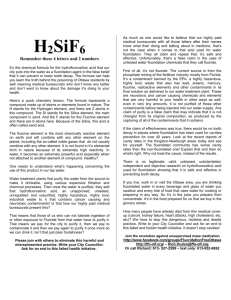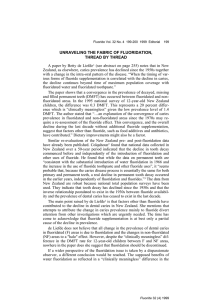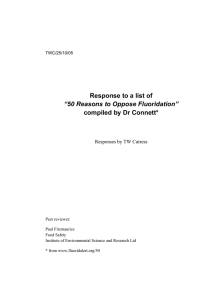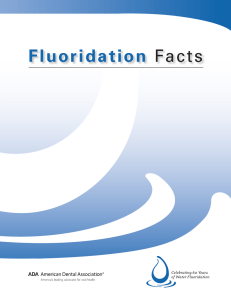Demonstrate knowledge of water treatment fluoridation processes
advertisement
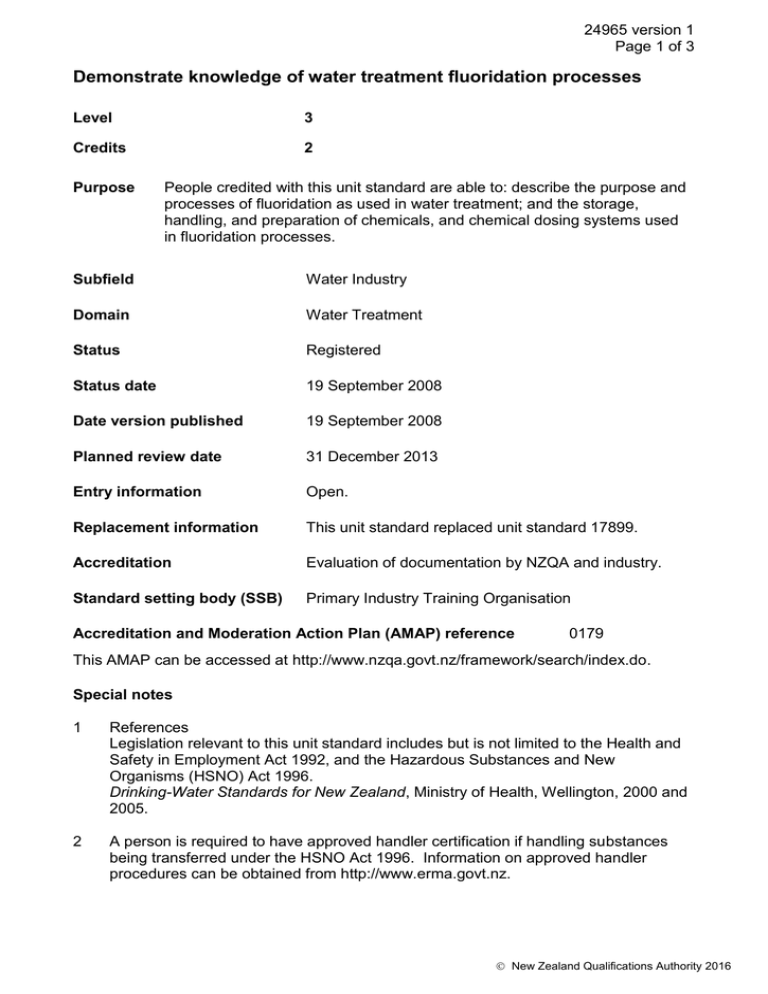
24965 version 1 Page 1 of 3 Demonstrate knowledge of water treatment fluoridation processes Level 3 Credits 2 Purpose People credited with this unit standard are able to: describe the purpose and processes of fluoridation as used in water treatment; and the storage, handling, and preparation of chemicals, and chemical dosing systems used in fluoridation processes. Subfield Water Industry Domain Water Treatment Status Registered Status date 19 September 2008 Date version published 19 September 2008 Planned review date 31 December 2013 Entry information Open. Replacement information This unit standard replaced unit standard 17899. Accreditation Evaluation of documentation by NZQA and industry. Standard setting body (SSB) Primary Industry Training Organisation Accreditation and Moderation Action Plan (AMAP) reference 0179 This AMAP can be accessed at http://www.nzqa.govt.nz/framework/search/index.do. Special notes 1 References Legislation relevant to this unit standard includes but is not limited to the Health and Safety in Employment Act 1992, and the Hazardous Substances and New Organisms (HSNO) Act 1996. Drinking-Water Standards for New Zealand, Ministry of Health, Wellington, 2000 and 2005. 2 A person is required to have approved handler certification if handling substances being transferred under the HSNO Act 1996. Information on approved handler procedures can be obtained from http://www.erma.govt.nz. New Zealand Qualifications Authority 2016 24965 version 1 Page 2 of 3 Elements and performance criteria Element 1 Describe the purpose of fluoridation as used in water treatment. Performance criteria 1.1 Fluoride levels are defined in accordance with the Drinking-Water Standards for New Zealand. 1.2 Fluoridation of public water supplies is described in terms of the impacts on health. Range dental health, other fluoride sources, natural fluoride, overdose health risks. Element 2 Describe fluoridation processes as used in water treatment. Performance criteria 2.1 The chemical sources of fluoride used in water treatment are described in terms of cost effectiveness and operator safety. Range 2.2 Fluoride addition methods used in water treatment are identified and described in terms of powder and liquid chemical sources. Range 2.3 sodium silico fluoride, hydrofluosilicic acid. dry powder feeders, carry water, liquid dosing and flow control. Chemical addition of fluoride is described in terms of existing natural fluoride levels, monitoring methods, dosing control methods, and impacts of dosage fluctuation. Range flow measurement, calibration, daily average dose of fluoride calculation, check tests, reporting of tests. Element 3 Describe the storage, handling, and preparation of chemicals, and chemical dosing systems used in fluoridation processes. Performance criteria 3.1 The storage, handling, and preparation of chemicals used in fluoridation processes are described in terms of the Health and Safety in Employment Act 1992, and the HSNO Act 1996 and regulations. New Zealand Qualifications Authority 2016 24965 version 1 Page 3 of 3 3.2 Chemical dosing systems used in fluoridation processes are described in terms of the components, methods, and points of application. Range components – chemical pipework, dosing pumps, speed control, stroke control, flow rate, tank of dilutant, instrumentation for automatic control. Please note Providers must be accredited by NZQA, or an inter-institutional body with delegated authority for quality assurance, before they can report credits from assessment against unit standards or deliver courses of study leading to that assessment. Industry Training Organisations must be accredited by NZQA before they can register credits from assessment against unit standards. Accredited providers and Industry Training Organisations assessing against unit standards must engage with the moderation system that applies to those standards. Accreditation requirements and an outline of the moderation system that applies to this standard are outlined in the Accreditation and Moderation Action Plan (AMAP). The AMAP also includes useful information about special requirements for organisations wishing to develop education and training programmes, such as minimum qualifications for tutors and assessors, and special resource requirements. Comments on this unit standard Please contact the Primary Industry Training Organisation standards@primaryito.ac.nz if you wish to suggest changes to the content of this unit standard. New Zealand Qualifications Authority 2016



